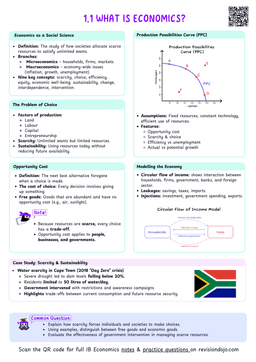The important aspect of balance of payments is the interdependence between the accounts (components) that is measured.
We will bring up the balance of payments example table for Country A from 4.6.2 Components of Balance of Payments.
| Line | Components | Figures (Millions of dollars) |
|---|---|---|
| 1 | Current Account | |
| 2 | Exports of Goods | +25 |
| 3 | Imports of Goods | -40 |
| 4 | Balance of Trade in Goods (Line 2 - 3) | -25 |
| 5 | Exports of Services | +15 |
| 6 | Imports of Services | -5 |
| 7 | Balance of Trade in Services (Line 5 - 6) | +10 |
| 8 | Balance of Trade in Goods & Services (Line 4 + 7) | -15 |
| 9 | Income (inflows - outflows) | -4 |
| 10 | Current Transfers (inflows - outflows) | +1 |
| 11 | Balance on Current Account (Line 8 + 9 + 10) | -18 |
| 12 | Capital Account | |
| 13 | Capital Transfers (inflows - outflows) | +1.1 |
| 14 | Transactions non-financial assets (inflows - outflows) | +0.9 |
| 15 | Balance on Capital Account (Line 13 + 14) | +2 |
| 16 | Financial Account | |
| 17 | Foreign Direct Investment (inflows - outflows) (FDI; inflows - outflows) | +18 |
| 18 | Portfolio Investment (inflows - outflows) | -3 |
| 19 | Reserve Assets (official reserves) | +2 |
| 20 | Official Borrowing | -1 |
| 21 | Balance of Financial Account (Line 17 + 18 + 19 + 20) | +16 |
| 22 | Balance (Line 11 + 15 + 21) | 0 |
Zero Balance in the Balance of Payments
- In balance of payments, the sum of all components is always 0.
- In other words, the sum of all credits and debits is 0, or credits are matched by the debits.
- This can also be stated as deficits are matched by the surpluses.
Observing in Country A's balance of payments accounts, the sum of surplus in the capital and financial account of +18 million USD is exactly matched by the deficit in the current account of -18 million USD.
Reasoning behind Zero Balance
- Recall, credits refer to the payments received by the economy from other economies and debits refer to the payments made from the economy.
- For credits, when other countries are trying to pay Country A, they must sell their own currency and demand Country A's currency.
- The same applies for payments made or debits by Country A, as they must sell their own currency and demand the other country's currency.
- Therefore, credits create demand for a currency and debits create supply of the currency.


